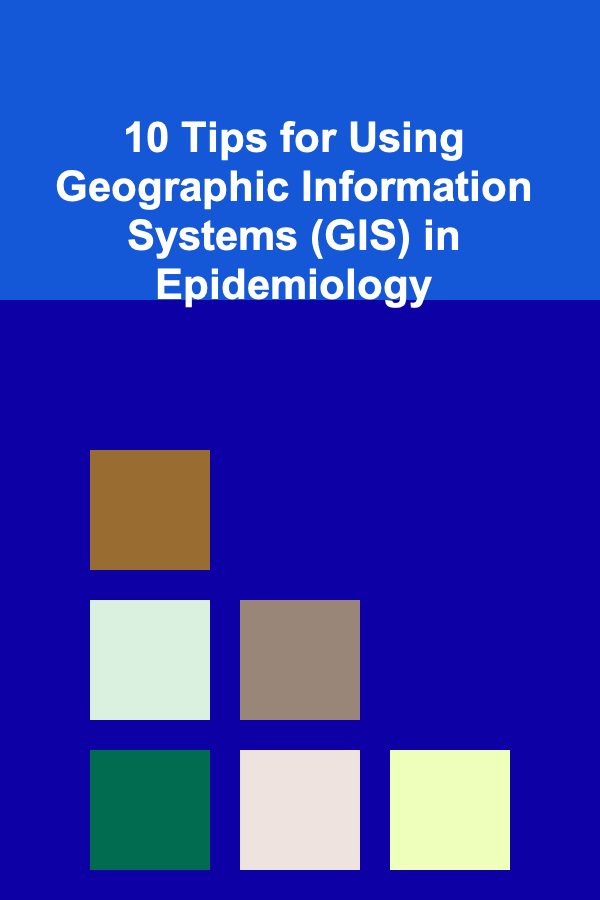
10 Tips for Using Geographic Information Systems (GIS) in Epidemiology
ebook include PDF & Audio bundle (Micro Guide)
$12.99$8.99
Limited Time Offer! Order within the next:

Geographic Information Systems (GIS) have become an essential tool in the field of epidemiology, helping researchers and public health professionals to map, analyze, and interpret spatial data related to the spread of diseases. GIS allows epidemiologists to gain insights into how diseases spread, identify high-risk areas, track health trends, and design targeted interventions. By leveraging GIS tools, epidemiologists can transform complex data into actionable insights that help protect public health.
In this article, we will discuss 10 tips for using GIS effectively in epidemiology. These tips will guide you through the process of collecting, analyzing, and interpreting geographic and health data to improve public health outcomes. Whether you're new to GIS or looking to refine your approach, these suggestions will help you make the most of GIS technology in epidemiology.
Understand the Role of GIS in Epidemiology
Before diving into the technical aspects of GIS, it is essential to understand how GIS can enhance epidemiological research and public health practice. GIS provides a framework for integrating and visualizing spatial data, which is crucial for studying disease patterns and risk factors. The role of GIS in epidemiology includes:
- Mapping Disease Incidence: GIS enables the visualization of disease incidence across different geographic areas, helping to identify trends and clusters.
- Environmental and Social Determinants: By analyzing geographic data, GIS can uncover correlations between disease and environmental, social, or economic factors.
- Outbreak Surveillance: GIS is used to track and predict outbreaks of infectious diseases, such as flu or COVID-19, by mapping affected areas and monitoring real-time data.
- Resource Allocation: GIS can guide the allocation of public health resources, ensuring that interventions are directed to areas with the highest need.
Understanding these core applications will allow you to apply GIS in ways that improve epidemiological outcomes, design better interventions, and respond more effectively to health crises.
Choose the Right Data for Analysis
The quality of your GIS analysis depends largely on the quality of the data you use. Epidemiological research requires accurate, timely, and relevant data. Here are some key types of data commonly used in GIS-based epidemiology:
- Health Data: This includes data on disease incidence, prevalence, mortality rates, and other health indicators. These data points can often be obtained from health departments, hospitals, and national health surveys.
- Environmental Data: Environmental factors such as air quality, temperature, rainfall, and water sources can impact the spread of diseases. GIS allows you to map these variables and analyze their relationship with disease.
- Demographic Data: Data on population density, age, income, and other demographic factors can be critical in identifying vulnerable populations.
- Geospatial Data: This includes coordinates, boundaries, and infrastructure data. Accurate geospatial data is necessary to map disease outbreaks and track their spread across geographic locations.
When collecting data, ensure it is accurate, up-to-date, and properly geocoded (linked to geographic coordinates). Inconsistent or outdated data can skew your analysis and lead to unreliable conclusions.
Use Geographic Units that Align with Your Research Goals
In epidemiological studies, you will often work with different geographic units to analyze patterns of disease spread. The geographic units you choose should align with the research questions and objectives. Common units include:
- Administrative Units: This includes regions such as countries, states, provinces, and municipalities. Administrative units are useful for broad epidemiological studies.
- Health Districts: These smaller geographic units are often used in localized epidemiological studies and can provide a more detailed analysis of disease patterns within specific communities.
- Grid-Based Units: Grid systems divide geographic areas into equal-sized cells, allowing for detailed spatial analysis. This approach is often used for disease modeling, such as predicting disease spread based on environmental factors.
- Household or Individual-Level Data: In some cases, you may want to collect and analyze data at the individual or household level. This approach is often used for case studies or clinical trials.
By selecting the appropriate geographic units, you ensure that your GIS analysis aligns with your research objectives and provides meaningful insights into disease patterns.
Integrate Multiple Layers of Data
One of the most powerful features of GIS is its ability to integrate multiple layers of data. In epidemiology, disease transmission is often influenced by a combination of factors, including environmental conditions, socioeconomic status, and healthcare access. By overlaying these factors on a single map, you can gain a more comprehensive understanding of disease dynamics.
- Environmental Factors: Overlay environmental data, such as climate or pollution levels, on top of health data to identify correlations between environmental conditions and disease spread.
- Demographic Data: Overlay demographic information (e.g., population density, age distribution) to identify areas where high-risk populations might be more susceptible to certain diseases.
- Healthcare Infrastructure: Map healthcare facilities (e.g., hospitals, clinics) alongside disease data to identify areas where healthcare access might be limited.
The ability to combine different layers of information allows you to visualize complex relationships and generate insights that would be difficult to obtain through traditional epidemiological methods.
Utilize Disease Mapping Techniques
Effective disease mapping is a key component of GIS in epidemiology. Mapping disease incidence and prevalence can help identify hotspots of disease, track its spread, and guide intervention strategies. There are several techniques you can use to create meaningful disease maps:
- Choropleth Maps: These maps use color gradients to represent different values of disease incidence within geographic areas. Choropleth maps are useful for visualizing trends and identifying areas with high or low disease rates.
- Dot Density Maps: Dot density maps represent individual cases of disease as dots on a map, which helps to visualize the concentration of cases in specific areas.
- Heat Maps: Heat maps use color intensity to show the density of disease cases in specific geographic areas. These maps can be used to identify clusters or areas with higher disease activity.
- Spatial Autocorrelation: GIS can also be used to analyze spatial autocorrelation, which is the degree to which disease patterns in one area are similar to those in neighboring areas. This analysis can help identify disease hotspots and predict future outbreaks.
By using appropriate mapping techniques, you can provide a visual representation of disease distribution that is easy to interpret and understand.
Conduct Spatial Analysis for Disease Clustering
Spatial analysis is a powerful tool within GIS that allows you to analyze the spatial relationships between disease cases and geographic factors. One common application of spatial analysis in epidemiology is the detection of disease clustering.
- Kernel Density Estimation (KDE): KDE is a technique used to estimate the concentration of disease cases in a specific geographic area. It can help identify areas where disease incidence is unusually high or low, providing valuable insights into disease hotspots.
- SaTScan: SaTScan is a statistical tool that uses GIS to detect spatial and temporal clusters of disease. It can identify geographic areas and time periods with an unusually high or low incidence of disease, which is useful for outbreak detection and surveillance.
- Spatial Regression: Spatial regression models can help identify relationships between disease rates and geographic variables, such as population density or environmental factors.
Spatial analysis tools like these allow you to go beyond simple disease mapping and gain a deeper understanding of the factors driving disease spread.
Incorporate Time into Your GIS Analysis
In epidemiology, time is a critical factor in understanding disease dynamics. GIS allows you to analyze disease patterns over time and track the evolution of outbreaks. Time-series analysis in GIS can help you:
- Track Disease Trends: By visualizing disease trends over time, you can monitor how disease rates change in specific geographic areas. This is crucial for identifying emerging outbreaks and assessing the effectiveness of interventions.
- Animate Disease Spread: GIS software allows you to create animated maps that show how disease spreads over time. These dynamic visualizations are useful for presentations and can help stakeholders understand the progression of an outbreak.
- Analyze Temporal Clusters: By combining spatial and temporal data, you can identify disease clusters that occur at specific times and locations, providing insight into the factors influencing disease transmission.
Incorporating time into your GIS analysis allows you to study disease patterns more comprehensively and predict future outbreaks.
Collaborate with Other Disciplines
GIS in epidemiology is most effective when it is used in conjunction with other disciplines, such as environmental science, sociology, and urban planning. Collaborating with experts from these fields can help you gain a more holistic understanding of disease dynamics.
- Environmental Scientists: Collaborate with environmental scientists to understand how factors such as pollution, water quality, and climate conditions affect disease spread.
- Sociologists: Work with sociologists to analyze how socioeconomic factors, such as income inequality and education, influence disease risk and access to healthcare.
- Urban Planners: Partner with urban planners to study how urbanization and infrastructure development impact the spread of disease in cities.
By working with professionals from other fields, you can incorporate a broader range of factors into your GIS analysis, leading to more comprehensive and accurate conclusions.
Train Your Team on GIS Tools and Techniques
Effective use of GIS in epidemiology requires specialized knowledge and skills. It is important to train your team on the tools and techniques needed to collect, analyze, and interpret GIS data. Training can include:
- GIS Software Training: Familiarize your team with GIS software (e.g., ArcGIS, QGIS) and its functions, including data input, spatial analysis, and mapping techniques.
- Data Management: Teach your team how to properly manage and organize geospatial data to ensure accuracy and consistency.
- Interpretation and Communication: Train your team to interpret GIS results and communicate findings to public health officials, policymakers, and the public.
Investing in GIS training for your team will ensure that everyone is equipped to use GIS tools effectively and can contribute to high-quality epidemiological research.
Ensure Data Privacy and Security
Finally, when working with GIS in epidemiology, it is important to be mindful of data privacy and security, especially when handling sensitive health information. Take steps to protect the confidentiality of patient data and comply with relevant data protection regulations, such as HIPAA in the United States or GDPR in Europe.
- Anonymize Data: Where possible, anonymize personal data to ensure that individuals cannot be identified.
- Secure Storage: Use secure servers and encryption to protect sensitive data from unauthorized access.
- Compliance: Ensure that your GIS analysis complies with all relevant laws and regulations regarding data privacy and security.
Maintaining data privacy and security is crucial for protecting individuals' rights and maintaining public trust in epidemiological research.
Conclusion
Geographic Information Systems (GIS) are an invaluable tool for epidemiologists, enabling them to analyze and visualize the spatial distribution of diseases, identify trends, and design targeted interventions. By following these 10 tips, you can make the most of GIS in epidemiology, ensuring that your research is accurate, actionable, and effective in improving public health outcomes. Whether you are tracking disease outbreaks, analyzing environmental factors, or allocating resources, GIS can enhance your ability to understand and address health challenges on a global scale.
Reading More From Our Other Websites
- [Organization Tip 101] How to Organize Audiobooks and Podcasts in Your Library
- [Tie-Dyeing Tip 101] How to Create Tie‑Dye Patterns on Hand‑Knitted Scarves
- [Needle Felting Tip 101] How Needle Felting Classes Can Spark Creativity and Reduce Stress
- [Personal Care Tips 101] How to Choose Perfume for Different Times of the Day
- [Ziplining Tip 101] Elevate Your Relationship: Romantic Ziplining Experiences That Will Never Be Forgotten
- [Home Soundproofing 101] How to Soundproof Your Apartment Without Losing Your Security Deposit
- [Tie-Dyeing Tip 101] Tie-Dye for Beginners: Essential Tools, Fabrics, and Safety Tips
- [Home Rental Property 101] How to Search for Rentals with an EV Charging Station
- [Personal Care Tips 101] How to Create a Hair Mask for Split Ends?
- [Organization Tip 101] How to Organize Your Kitchen Pantry by Food Groups

How to Organize a Kid's Playroom with Clever Furniture Choices
Read More
How to Plan a Successful Conference: A Complete Checklist
Read More
How to Set and Achieve Your Financial Goals
Read More
How to Stage Your Home for Maximum Storage Appeal
Read More
How to Prep Your Pet for Holiday Travel
Read More
How to Plan a Successful Nonprofit Capital Campaign
Read MoreOther Products

How to Organize a Kid's Playroom with Clever Furniture Choices
Read More
How to Plan a Successful Conference: A Complete Checklist
Read More
How to Set and Achieve Your Financial Goals
Read More
How to Stage Your Home for Maximum Storage Appeal
Read More
How to Prep Your Pet for Holiday Travel
Read More